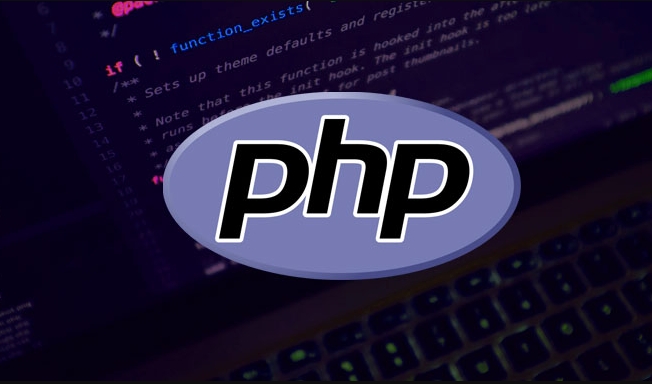In PHP regular expressions, use ^ and $ anchors to match the beginning and end of a string respectively. 1. ^ means the beginning of the string, ensuring that the matching content appears from the beginning, such as /^hello/, verify whether it starts with hello; 2. $ means the end of the string, such as /.jpg$/, verify whether it ends with .jpg; 3. Use ^ and $ in combination to achieve a complete match, such as /^abc\d $/ to ensure that the entire string conforms to the specified format; 4. In multi-line mode, ^ and $ will match the beginning and end of each line respectively; 5. Note that the ending line breaks may affect the matching result, and you can use \s* or trim() to avoid problems. Mastering these details can improve the accuracy of regular expressions.

In PHP regular expressions, if you want to match a pattern that must appear at the beginning or end of a string, you need to use the "first line" and "first line" anchors. These anchors themselves do not match any characters, but rather indicate positions. Understanding how they are used will allow you to write more accurate regular expressions.

^ indicates the beginning of the string
This symbol is used to ensure that the matching content appears from the beginning of the string. For example, if you want to determine whether a string starts with "hello":

if (preg_match('/^hello/', $string)) {
// Match successfully}As long as “hello” is not the first word to appear, it will not match.
Note: If you enable multi-line mode (add the
mmodifier),^will also match the beginning of each line.
Common uses:
- Verify that the input starts with a specific content
- Extract data with fixed format prefixes
$ means the end of the string
Similar to ^ , $ is another anchor point that matches the end position of the string. For example, you want to confirm whether a string ends in .jpg :
if (preg_match('/\.jpg$/', $filename)) {
// It's a picture file} If the file name is photo.jpg.zip , it does not match; if it is photo.jpg , it does not match.
Similarly, in multi-line mode,
$will also match the end of each line.
Combination: Completely match the entire string
When you need to exactly match a string, you can use ^ and $ to limit the entire structure:
if (preg_match('/^abc\d $/', $input)) {
// The input must be abc followed by one or more numbers} This can prevent partial matching situations like xabc123y . This writing method is very useful when verifying user input.
To give a few common examples:
- Email format verification (although it cannot be completely based on regularity)
- Fixed length number, password format requirements
- URL path rule matching (such as
/user/\d)
Note: End line breaks may also affect the results
Sometimes when you are working on text, the ending may have a newline character \n or \r\n . If you use the $ anchor point but do not add the modifier D , it will still think that $ is preceded by the end of the string, not the newline.
One solution is to add \s* to the end to ignore the blank, or use trim() to process the string before making a match.
Basically that's it. Mastering the use of ^ and $ can help you avoid many mismatch problems. Although it may seem simple, details are easily overlooked in practical applications, especially when dealing with user input or complex formats.
The above is the detailed content of php regex start of string and end of string anchors. For more information, please follow other related articles on the PHP Chinese website!

Hot AI Tools

Undress AI Tool
Undress images for free

Undresser.AI Undress
AI-powered app for creating realistic nude photos

AI Clothes Remover
Online AI tool for removing clothes from photos.

Clothoff.io
AI clothes remover

Video Face Swap
Swap faces in any video effortlessly with our completely free AI face swap tool!

Hot Article

Hot Tools

Notepad++7.3.1
Easy-to-use and free code editor

SublimeText3 Chinese version
Chinese version, very easy to use

Zend Studio 13.0.1
Powerful PHP integrated development environment

Dreamweaver CS6
Visual web development tools

SublimeText3 Mac version
God-level code editing software (SublimeText3)

Hot Topics
 How do I implement authentication and authorization in PHP?
Jun 20, 2025 am 01:03 AM
How do I implement authentication and authorization in PHP?
Jun 20, 2025 am 01:03 AM
TosecurelyhandleauthenticationandauthorizationinPHP,followthesesteps:1.Alwayshashpasswordswithpassword_hash()andverifyusingpassword_verify(),usepreparedstatementstopreventSQLinjection,andstoreuserdatain$_SESSIONafterlogin.2.Implementrole-basedaccessc
 How can you handle file uploads securely in PHP?
Jun 19, 2025 am 01:05 AM
How can you handle file uploads securely in PHP?
Jun 19, 2025 am 01:05 AM
To safely handle file uploads in PHP, the core is to verify file types, rename files, and restrict permissions. 1. Use finfo_file() to check the real MIME type, and only specific types such as image/jpeg are allowed; 2. Use uniqid() to generate random file names and store them in non-Web root directory; 3. Limit file size through php.ini and HTML forms, and set directory permissions to 0755; 4. Use ClamAV to scan malware to enhance security. These steps effectively prevent security vulnerabilities and ensure that the file upload process is safe and reliable.
 What are the differences between == (loose comparison) and === (strict comparison) in PHP?
Jun 19, 2025 am 01:07 AM
What are the differences between == (loose comparison) and === (strict comparison) in PHP?
Jun 19, 2025 am 01:07 AM
In PHP, the main difference between == and == is the strictness of type checking. ==Type conversion will be performed before comparison, for example, 5=="5" returns true, and ===Request that the value and type are the same before true will be returned, for example, 5==="5" returns false. In usage scenarios, === is more secure and should be used first, and == is only used when type conversion is required.
 How do I perform arithmetic operations in PHP ( , -, *, /, %)?
Jun 19, 2025 pm 05:13 PM
How do I perform arithmetic operations in PHP ( , -, *, /, %)?
Jun 19, 2025 pm 05:13 PM
The methods of using basic mathematical operations in PHP are as follows: 1. Addition signs support integers and floating-point numbers, and can also be used for variables. String numbers will be automatically converted but not recommended to dependencies; 2. Subtraction signs use - signs, variables are the same, and type conversion is also applicable; 3. Multiplication signs use * signs, which are suitable for numbers and similar strings; 4. Division uses / signs, which need to avoid dividing by zero, and note that the result may be floating-point numbers; 5. Taking the modulus signs can be used to judge odd and even numbers, and when processing negative numbers, the remainder signs are consistent with the dividend. The key to using these operators correctly is to ensure that the data types are clear and the boundary situation is handled well.
 How can you interact with NoSQL databases (e.g., MongoDB, Redis) from PHP?
Jun 19, 2025 am 01:07 AM
How can you interact with NoSQL databases (e.g., MongoDB, Redis) from PHP?
Jun 19, 2025 am 01:07 AM
Yes, PHP can interact with NoSQL databases like MongoDB and Redis through specific extensions or libraries. First, use the MongoDBPHP driver (installed through PECL or Composer) to create client instances and operate databases and collections, supporting insertion, query, aggregation and other operations; second, use the Predis library or phpredis extension to connect to Redis, perform key-value settings and acquisitions, and recommend phpredis for high-performance scenarios, while Predis is convenient for rapid deployment; both are suitable for production environments and are well-documented.
 How do I stay up-to-date with the latest PHP developments and best practices?
Jun 23, 2025 am 12:56 AM
How do I stay up-to-date with the latest PHP developments and best practices?
Jun 23, 2025 am 12:56 AM
TostaycurrentwithPHPdevelopmentsandbestpractices,followkeynewssourceslikePHP.netandPHPWeekly,engagewithcommunitiesonforumsandconferences,keeptoolingupdatedandgraduallyadoptnewfeatures,andreadorcontributetoopensourceprojects.First,followreliablesource
 What is PHP, and why is it used for web development?
Jun 23, 2025 am 12:55 AM
What is PHP, and why is it used for web development?
Jun 23, 2025 am 12:55 AM
PHPbecamepopularforwebdevelopmentduetoitseaseoflearning,seamlessintegrationwithHTML,widespreadhostingsupport,andalargeecosystemincludingframeworkslikeLaravelandCMSplatformslikeWordPress.Itexcelsinhandlingformsubmissions,managingusersessions,interacti
 How to set PHP time zone?
Jun 25, 2025 am 01:00 AM
How to set PHP time zone?
Jun 25, 2025 am 01:00 AM
TosettherighttimezoneinPHP,usedate_default_timezone_set()functionatthestartofyourscriptwithavalididentifiersuchas'America/New_York'.1.Usedate_default_timezone_set()beforeanydate/timefunctions.2.Alternatively,configurethephp.inifilebysettingdate.timez







